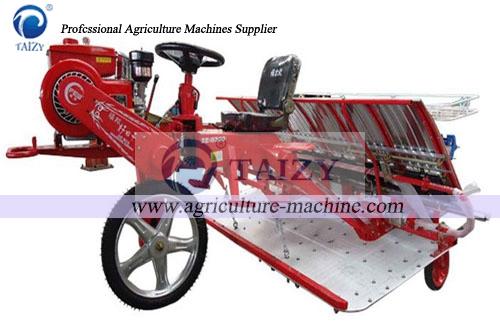The transplanting mechanism is the main working part of rice transplanter, which is composed of the transplanter, its driving mechanism and track control mechanism. Under the control of the driving mechanism and the track control mechanism, the seedling extractor will separate a certain number of seedlings from the seedling box and insert them into the soil according to a certain track, and then return to the original position to start the next cycle. According to the movement of seedling, there are two vertical and horizontal.
①The horizontal transplanter has seedling clip suitable for pulling seedling planting and cutting seedling claw suitable for taking soil seedling planting, and the two can be used interchangeably according to the need. The rice seedling clip is composed of a movable clip and a fixed clip. The cutting and palletizing rice seedling is carried by taking away rice seedling pieces so that the seedling with soil can be removed smoothly from the seedling claws.
②The vertical transplanter has the comb claws suitable for pulling seedling and planting, the comb claws suitable for carrying the soil seedling and planting, or the chopstick ones. In the process of separating rice seedling, the comb seedling claw can distinguish seedling. When the chopstick claw is inserted into the seedling with soil, the seedling with soil is forced out by pushing the seedling with soil.
A certain number of rice transplanter are arranged on the rows of rice seedlings (or rice seedlings) at specified distances. In the rolling vertical transplanter, there are 2 ~ 4 rice seedling claw rows, which are connected with the rotary arm of rotary slotted in circular motion. On a swinging rice transplanter. Generally, a rice claw row is articulated with a swinging arm for reciprocating swing, or a seedling catcher can be installed directly on a set of crank-link linkages for grouping drive. In most rice transplanters, the movement track of the rice transplanter is controlled by the control mechanism besides the driving mechanism. The commonly used track control mechanisms include guide channel, slide, CAM, planetary gear and four-bar mechanism, which are combined with various driving mechanisms to form various types of seedling transplanting mechanisms.

